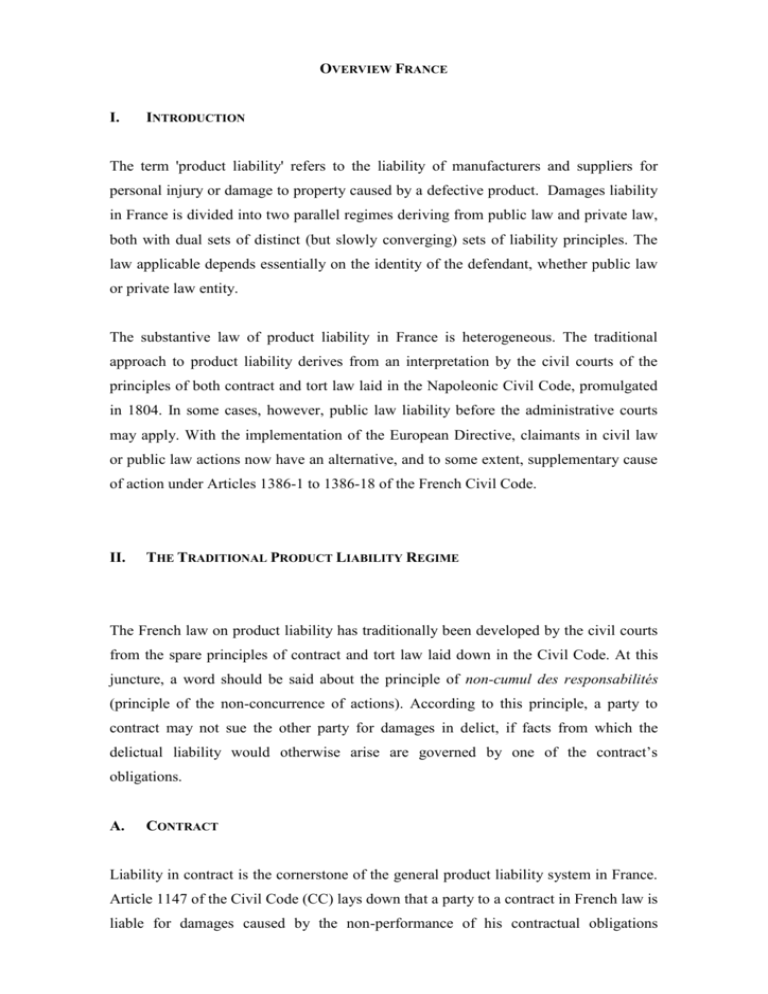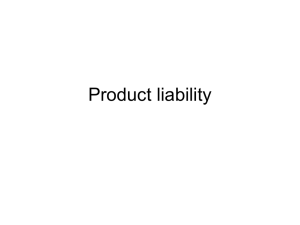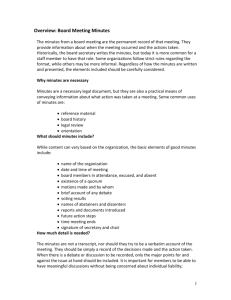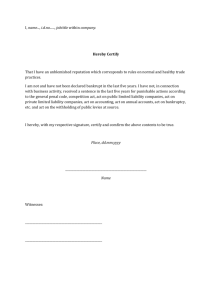2. Obligation de sécurité - British Institute of International and
advertisement

OVERVIEW FRANCE I. INTRODUCTION The term 'product liability' refers to the liability of manufacturers and suppliers for personal injury or damage to property caused by a defective product. Damages liability in France is divided into two parallel regimes deriving from public law and private law, both with dual sets of distinct (but slowly converging) sets of liability principles. The law applicable depends essentially on the identity of the defendant, whether public law or private law entity. The substantive law of product liability in France is heterogeneous. The traditional approach to product liability derives from an interpretation by the civil courts of the principles of both contract and tort law laid in the Napoleonic Civil Code, promulgated in 1804. In some cases, however, public law liability before the administrative courts may apply. With the implementation of the European Directive, claimants in civil law or public law actions now have an alternative, and to some extent, supplementary cause of action under Articles 1386-1 to 1386-18 of the French Civil Code. II. THE TRADITIONAL PRODUCT LIABILITY REGIME The French law on product liability has traditionally been developed by the civil courts from the spare principles of contract and tort law laid down in the Civil Code. At this juncture, a word should be said about the principle of non-cumul des responsabilités (principle of the non-concurrence of actions). According to this principle, a party to contract may not sue the other party for damages in delict, if facts from which the delictual liability would otherwise arise are governed by one of the contract’s obligations. A. CONTRACT Liability in contract is the cornerstone of the general product liability system in France. Article 1147 of the Civil Code (CC) lays down that a party to a contract in French law is liable for damages caused by the non-performance of his contractual obligations -2‘whenever he fails to prove that such non-performance results from an external cause which cannot be imputed to him, even though there is no bad faith on his part.’ In respect of sales contracts, contrats de ventes, the Civil Code imposes two principal obligations on the seller: an obligation to deliver and an obligation to guarantee the goods he sells (Article 1603 CC). The latter obligation is the most important in the context of product liability. It should also be noted that under French law, a party to a contract is not only bound by the provisions stipulated in the said contract, but is also bound by duties developed by the courts. There are a series of such obligations, of which the most important is the obligation de sécurité. We will examine in greater depth the obligation to guarantee against defects and the obligation de sécurité. 1. Obligation to guarantee against defects The case of defective goods which cause either personal injury or property damage to the buyer is governed by several provisions set forth in the Civil Code referred to as the ‘latent defect warranty’ (‘garantie contre les vices cache’).1 The origins of this obligation can be traced back to Roman law.2 With respect to latent defects, Article 1641 CC provides that the seller guarantees the goods sold against hidden defects rendering the goods improper for the use for which it is intended.3 Four conditions must be met for the warranty to apply: 4 (1) the product is defective; (2) the defect was hidden (3) the defect was present prior to the transfer of property of the goods (4) the defect is material enough to render the product unfit for use or to materially reduce its value. In principle, contractual product liability requires the existence of a sale contract between the defendant and claimant. Importantly, however, the ‘latent defect warranty’ has been extended by the courts to all buyers and sub-buyers in the distribution chain. A 1 See Articles 1625, 1641-1648 CC. See discussion of J. Bell, French Legal Cultures (London, Butterworths, 2001) page 79. 3 For a full English translation of the French Civil Code, see: www.legifrance.gouv.fr. 4 See Articles 1641-1648 CC. 2 -3consumer can thus sue the manufacturer directly for latent defects in products sold to him by a retailer.5 A variety of remedies are available for the breach of this warranty, including recovery of the purchase price, rescission of sale, and a damages claim. For damages to be awarded, the Civil Code lays down the condition that the seller knew of the defect at the time of sale.6 However the French courts have softened the burden of having to prove knowledge by first applying an evidential presumption that professional sellers should, due to their special professional expertise be aware of, at the time of sale, latent defects in the products which they sell.7 This has subsequently been transformed into a substantive rule: professional sellers are strictly liable to the buyer for damage caused by hidden defects in the goods.8 The broad notion of “professional seller” ensures that this rules extends to both manufacturers of a product but also professional reseller (eg a distributor or retailer). Despite this judicial liberalism, there are weakness in basing an action on the ‘latent defect warranty’. The primary problem has been the short limitation period. Article 1648 CC provides that these actions ‘must be brought by the buyer within a short time, depending on the nature of the material defects and the custom of the place where the sale was made.’ This has been interpreted to mean that the buyer must file a claim within a ‘short period’ of the date of discovery of the latent defect, or the date when the defect could reasonable have been discovered.9 2. Obligation de sécurité 5 Cass com 24 November 1987, Bull Civ IV N 250. Article 1645 CC: “ Where the seller knew of the defects of the thing, he is liable, in addition to restitution of the price which he received from him, for all damages towards the buyer.” 6 7 Cass civ 1 24 November 1954 JCP 955.II.8565. S. Taylor, “The harmonisation of European product liability rules: French and English law” 48 (1999) International and Comparative Law Quarterly 419, 425. 8 9 Cass com 18 February 1992, Bull civ IV N82; Com 3 May 1974 JCP 1974.II.17798. -4In a number of cases during the 1990s, the French Cour de Cassation reinforced the protection afforded in product liability cases by developing the notion that ‘vendeurs professionels’ undertake an obligation to deliver a safe product over and above the ‘latent defect warranty’ or garantie des vices caches. The extent of the obligation, known as an obligation de sécurité, is impressive. The Cour de Cassation has stated that ‘the seller acting in his professional capacity must deliver products that are free from any defects likely to cause harm to people or goods.’10 Sellers and manufacturers are thus subject to an ‘obligation de résultat’ (strict liability): the products must guarantee ‘the necessary level of security which a consumer expects.’ This obligation de sécurité also applies equally to sellers and manufacturers. The French case law has developed to provide that the contractual action for failure to deliver safe products passes to the downstream buyer or user, thereby avoiding problems arising from the lack of direct contractual relationship, in common law parlance the problem of the privity of contract.11 This case law was heavily influenced by the European Directive. Indeed, in a decision handed down in 1998, only a few months before the implementation of the Product Liability Directive in France, the Cour de Cassation delivered a judgment explicitly following the wording of the Directive and held that the producer is under a ‘safety duty’ when selling a product, such safety being that ‘which a person is legitimately entitled to expect.’12 Consequently, even before the transposition of the European Directive, its effects were being felt in the case law. The Cour de Cassation had to some extent remedied the inaction of the legislator. B. TORT 1. Article 1382 of the French Civil Code Le ‘vendeur professionel’ ‘est tenu de livrer un produit exempt de tout défaut de nature à créer un danger pour les personnes ou les biens’ (Cass civ 1, 20 March 1989, Dalloz 1989.581, note Malaurie). Cf Cass civ 1, 11 June 1991 JCP 1992.I.3572 obs Viney. 10 11 12 See Cass civ 1, 9 March 1983, Bull civ I N 92; JCP 1984.II.20295. Cass civ 1, 3 March 1998, Dalloz 1998 IR 96. Cf Cass civ 1, 28 April 1998, Dalloz 1998 IR 142 (reference to “les articles 1147 et 1384, alinéa premier, du Code civil, interprétés à la lumière de la directive CEE n° 85-374 du 24 juillet 1985.”) -5Article 1382 of the French Civil Code memorably provides that : ‘tout fait quelconque de l’homme, qui cause à autrui un dommage, oblige celui par la faute duquel il est arrive, à le réparer.’ Under the wording of Article 1382 CC, proof of fault on the part of the defendant is a prerequisite of liability. However, the notion of fault has a rather different meaning in French law, than in the common law.13 This is illustrated in the sphere of product liability. Initially requiring proof of fault on the part of the defendant, the French courts have now shifted the focus of analysis from the producer’s behaviour to the product itself, merely requiring the proof of delivery of a defective product: ‘delivery of a defective product is sufficient to establish fault on the part of the manufacturer or the distributor.’14 The claimant has thus practically been exempted from having to prove fault so long as he can demonstrate that the products were defective and that such defective products were the cause of his damage or injury. So, the mere marketing of defective products constitutes proof of the manufacturer’s fault. This is an important development of the law in favour of the victims of the effects of product defects. A strict liability “obligation de sécurité” thus applies under both the law of contract and tort. Manufacturers and suppliers are thus subject to this duty in respect of either a buyer under contract or a third party victim.15 2. Article 1384 (1) of the French Civil Code Article 1384 (1) of the French Civil Code provides that ‘[o]n est responsable non seulement du dommage que l’on cause par son propre fait, mais encore de celui qui est 13 J. Bell, S. Boyron, and S. Whittaker, Principles of French Law (Oxford, 1998) page 357 et seq. For the differences in conception of fault in governmental liability cases, see D. Fairgrieve, State Liability in Tort: A Comparative Law Study (Oxford, 2003). 14 15 Cass civ 1 18 July 1972, Bull civ 1 N189. The influence of European law again should be recognised. Taylor summarises this development of the law as follows: “French judges have therefore anticipated the incorporated of the Directive by centring liability on the notion of “defect”, but do not allow a development risks defence.” (S. Taylor, “The harmonisation of European product liability rules: French and English law” 48 (1999) International and Comparative Law Quarterly 419, 427). -6causé par le fait des personnes dont on doit répondre, ou des choses que l’on a sous sa garde.’ The French courts have broadly interpreted the provisions of Article 1384 (1) CC so as to impose strict liability for the ‘deeds of things within one’s keeping.’16 An employer is thus strictly liable as a gardien of factory machinery for the personal injuries which it caused. In these cases, the only defences are if a gardien can show force majeure or contributory fault of the victim. The notion of liability for things in one’s keeping might seem prima facie to exclude product liability, given that the essence of the subject matter is a transfer of the product from the producer or supplier to the consumer. However, the French courts have asserted that la garde may be split and have drawn a distinction between the garde du comportement and garde de la structure. The former is the person who is responsible for harm caused by the thing’s behaviour, the latter is the person responsible for harm caused by its defects. In this way, the manufacturer of the product may be considered to have retained control over the structure of a product, even if it lost the garde du comportement in favour of the owner. Liability may stem from the responsibility for the structure of the product. The application of Article 1384 CC in product liability cases is however limited. There are some cases in which Article 1384 CC has been applied in the product liability field, but these have generally been limited to situations involving products which have exploded, where no other basis for liability was readily apparent. III. PRODUCT LIABILITY LAW UNDER THE IMPLEMENTED EC DIRECTIVE The traditional approach to product liability has been modified by the European Directive. The implementation of the European Product Liability Directive 85/374/EEC into French Law has been a complex process. The implementation was both delayed, and when it eventually occurred, has been declared to be inaccurate. The European Directive was implemented in France by virtue of a Law of 19 May 1998, that is to say 16 J. Bell, S. Boyron, and S. Whittaker, Principles of French Law (Oxford, 1998) pages 371-383. -7a full 10 years after the deadline. The implementation was effected by modifying the French Civil Code, and the new provision are contained in Article 1386-1 to 1386-18. However, in infringement proceedings brought by the European Commission, the implementation of the Directive into the French Civil Code has been held by the European Court of Justice (ECJ) to be incorrect.17 In its decision, the ECJ found that France had incorrectly implemented the Directive in three specific respects: the lack of a threshold for damage; the position regarding the liability of suppliers; and the conditions applying to defences. Concerning the threshold for damage, the ECJ found that the new provisions of the French Civil Code covered, unlike Article 9(b) of the Directive, all property damage. The lower threshold of 500 Euros had wrongfully been omitted. As to the position regarding suppliers, the ECJ held that the French Civil Code wrongly equates the position of the supplier with that of the producer, unlike Article 3(3) of the Directive, where the liability of suppliers is conceived as only subsidiary liability, applicable where the producer is unknown. Finally, in respect of the two defences outlined in Article 7 of the Directive (including the development risk defence), the ECJ held that French law had wrongly imposed the additional pre-condition that the producer of an obligation monitor the product: a producer is unable to invoke such a defence where the defect in the product was discovered with ten years of putting the product into circulation, and during that period the producer did not take the appropriate measures to avoid the damaging consequences. A number of key provisions of the French Civil Code are thus in breach of EU Law. The current position regarding these provisions of the Civil Code is somewhat unclear. No amendments have yet been brought forwarded. The French Ministry of Justice has explained the continuing delays in correcting the position of the Civil Code on the basis of the “length of the consultation period” and the “difficulty in selecting an appropriate Bill” to introduce the amendments.18 In the meantime, the status of the current offending provisions produces some confusion over the regime to be applied. 17 18 Case C-52/00 Commission v France, [2002] ECR I-3827, para 24. Rapport d’Information, sur l’Etat de Transposition des Directives Européennes (Assemblée Nationale, 9 July 2003), page 173. -8- IV. CO-EXISTENCE OF THE PREVIOUS TWO RÉGIMES Following the implementation of the 1985 European Directive into the French Civil Code in Article 1386-1 to 1386-18, the question has arisen as to the continuing vitality of the traditional case law developed by the courts in product liability cases. Can the French courts continue to apply their traditional case law in parallel to the protection afforded by the 1985 European Directive as implemented in the French Civil Code? Despite the principle of harmonisation enshrined in the European Directive, recent decisions at international and national level suggest that the French courts will continue to apply a certain amount of their traditional case law, thereby maintaining a rich tapestry of legal provisions in this area. In the Directive, the continued application of pre-existing systems of liability is covered by Article 13, which provides that: ‘This Directive shall not affect any rights which an injured person may have according to the rules of the law of contractual or noncontractual liability or a special liability system existing at the moment when this Directive is notified.’ Classically viewed as permitting the co-existence of parallel contractual and extracontractual actions,19 the European Court of Justice has recently analysed Article 13 in detail.20 The following principles flow from its decisions. Article 13 does not mean that a Member State can maintain a general system of product liability different from that provided for in the Directive. Rather Article 13 posited the co-existence of product liability systems of a different type, “based on other grounds, such as fault or a warranty in respect of latent defects” or with special liability systems relating to specific types of products. As a consequence of the ECJ’s interpretation of Article 13, the French courts will probably no longer be able to continue to invoke the co-existence of the obligation de sécurité regime with that under the Directive (as this is “founded on the same basis” as the Directive). However, there is nothing to prevent the continued application of the S. Taylor, “The harmonisation of European product liability rules: French and English law” 48 (1999) International and Comparative Law Quarterly 419, 420. 20 Case C-183/00 Gonzalez Sanchez v Medicina Asturiana SA, judgment of 25 April 2002; Case C-52/00 Commission v France, [2002] ECR I-3827. 19 -9traditional French rules of delict or the contractual warranty in respect of latent defects. In this sense, the parallel regimes will prevail. Some authors have even pointed out that the obligation de sécurité may enjoy a continued vitality by means of the application of Article 1382 of the Civil Code, a regime explicitly allowed to co-exist and one in respect of which it is increasingly accepted that liability is satisfied by a breach of the obligation de sécurité. V. STATE COMPENSATION SCHEMES In France, a fund has been set up to compensate those infected with HIV as a result of having received contaminated blood products.21 There is also a fund for those who have been disabled as a result of vaccination.22 A fund has also been established to compensate victims of asbestos-related diseases, known as the Fonds d’Indemnisation de Victimes de l’Amiante (Law of 23 December 2000). Claims may be brought by person (or next-of-kin) who have suffered asbestosrelated health problems, whether work-acquired or environmental. A new and radical medical compensation system has recently been introduced by means of a Statute of 4 March 2002.23 This statute has an ambitious and broad ambit, but the key feature of the law is the new medical compensation system. 21 Law N°91-1406 of 31 December 1991, article 47. 22 France: Law of 1 July 1964, now enshrined in art L 10-1 Code de la Santé Publique. 23 Law N 2002–303 of 4 March 2002, Gazette du Palais, 4 April 2002, Bulletin Législatif 2002.113 (Loi relative aux droits des malades et à la qualité du système de soins). See generally C. Rade, ‘La Réforme de la Responsabilité Médicale après la loi du 4 Mars 2002 rélative aux droits des maladies et à la qualité du système de santé’ [2002] Responsabilité Civile et Assurances 4; Y. Lambert-Faivre, ‘La loi N 2002-303 du 4 mars 2002 relative aux droits des maladies et à la qualité du système de santé: - 10 - VI. STATE LIABILITY There is a separate jurisdiction for determining damages cases against the state as actions go before the administrative courts. Public law liability before the public law courts is essentially a case-law development, based upon an extensive notion of administrative fault (faute de service), and a number of heads of no-fault liability. There have been a series of cases concerning regulatory liability of the state, some of these concerning products-related cases. In one case, the State was found liable for failure to supervise adequately the blood provision service and to implement measures to avoid contamination of the blood.24 In a recent decision of 3 March 2004, the Conseil d’Etat held the State liable for failing adequately to undertake its responsibilities to prevent risks at work from asbestos. The court noted that the toxic nature of asbestos was known since the mid-50s, but that measures were implemented to reduce risks only in 1977, and no in-depth study undertaken by authorities until 1995. The omission of state to take preventive measures to reduce risks of asbestos constituted a fault: “whilst the employer is obliged to protect the health of the employees under his control, it is beholden upon the public authorities who are charged with the prevention of risks at work to inform themselves of the dangers which workers can encounter during their professional activity.” Duncan Fairgrieve L’indemnisation des accidents médicaux’ Dalloz 2002 Chroniques 1367, 1371; M. Deguergue, ‘Droits des Malades et Qualité du Système de Santé’ AJDA 2002.508. 24 CE 9 April 1993, Monsieur G, [1993] Recueil des Décisions du Conseil d’Etat 110.







